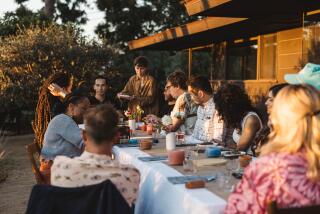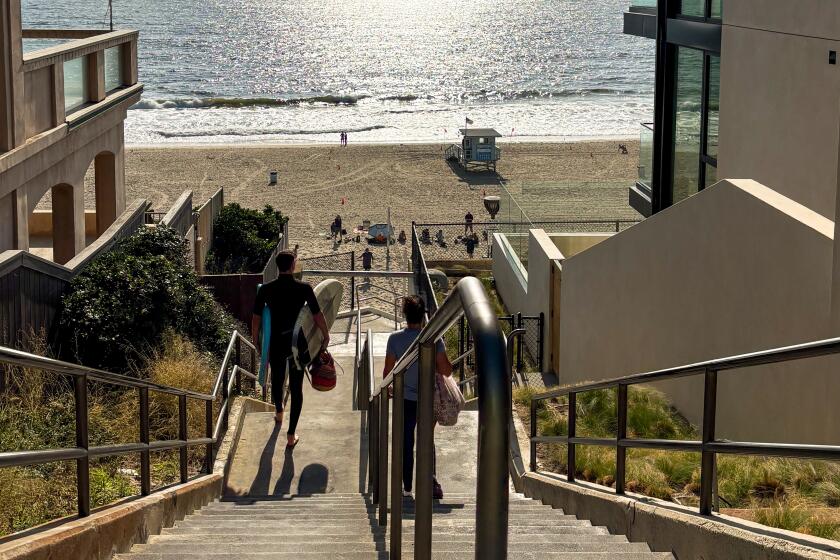Swaying to an island rhythm
Party guests have begun to arrive even before the appointed hour of 5 at the Malibu home of Chantal and Carl Gillberg, high on a distant knoll of the Santa Monica Mountains. A haze has settled over the sliver of ocean view, but in the terraced gardens above the main house, the sun is luminous on the surface of the swimming pool, where the hosts have just cooled off with a couple of their French friends. Two Haitian women in bare feet and dark glasses sit talking in the shade of an umbrella.
Tables are already set for dinner on the lawn outside the couple’s rustic ranch-style house — bounded by a profusion of tropical flora — and exuberant Caribbean music bursts forth through the screen doors of the lanai. Far across the way, at the crest of another ridge, a white horse frisks about a weathered wood fence and Angus cows graze in the canyon below among the chaparral. There is the unmistakable atmosphere here of a permanent holiday retreat in a place both wild and well tended, made for letting the good times roll.
Big, rollicking parties with an international guest list are a Gillberg specialty. Twist up five miles of canyon road, turn onto a long dirt drive, enter the double doors of a crowd-friendly house and toss off all your constraints. They expect you to kick back and enjoy yourself as much as they do.
“We like to share with other people — we do that frequently,” says Carl, a designer and craftsman,
who has emerged in the dining room in shorts and sandals, hair still wet from the outdoor shower. “And we like to have fun.”
Chantal, Carl’s business partner and also a partner in a West Hollywood art gallery, is in the kitchen checking a pot of chicken Creole on the stove and speaking animated French with an old friend from her native country of Haiti.
“People are over here a lot,” she says. “Many times clients come to Carl’s studio and we entertain them too. Haitians love gatherings, they love entertaining. It’s part of our culture. So the house is living all the time. As much as Carl and I work, we also pretty much like to live the good life. Ah. C’est naturel. C’est beau.”
One could scarcely imagine a more seemly home for the savoir-faire style of the Gillbergs, with its easy elegance and look of having been designed, in equal measure, for private and public amusement. Rooms spill unselfconsciously into other rooms: Curtains rather than doors separate the wide passageway from the living area to the dining room, from which the bedroom is boldly revealed. Burnished concrete floors in the two main rooms effortlessly accommodate the flow of visitors and the dancing that often follows dinner parties.
“The house has a very Caribbean feeling to it,” says Chantal, “but more French Caribbean.”
Every room is fertile with artistry. With the exception of a few big pieces of furniture — sofa, chairs, bed — everything in the interior is one-off and handmade, and mostly by Carl. Mirrors, tables, tiles, urns, lamps, sculpture, the mantel, the chandelier, the hot tub, the chess set: Look left, right, up, down, and there, again, is another example of the variety of decorative and functional pieces that have made him widely sought after by architects and interior designers for clients such as Bill Gates and Barbra Streisand and for hotels, casinos, country clubs, corporate offices and medical facilities.
“I work with all kinds of materials,” Carl says as he walks around his open-air studio space just outside the kitchen. Glass, ceramics, wood, iron, steel, bronze. “What I do is different from fine art. It’s really based on craft and design.”
He is known for his one-of-a-kind, large-scale pieces (which can be seen on his website https://www.gillbergdesign.com ), particularly the monumental ceramics reaching heights of almost 7 feet. “A lot of what I do is kind of conjoined with architecture because they’re architectural elements that are integrated with interior design.”
Carl has lived and worked on the 10-acre property for 42 years, since he was a budding artist of 22 who learned to carve wood and bamboo figurines from a group of Easter Islanders during a year he spent in Chile.
When he and Chantal married 18 years ago, the property had only three small rooms, “a very simple structure, a barn-like studio residence,” he says. “We just reconfigured it and grew it, bit by bit — sometimes it took years to execute something.
“We’re true partners, right together in all decisions. She has a lot of great ideas about what a home and gardens should be. Basically I try to make happen those ideas. My livelihood comes from making beautiful things to enhance other people’s lives — so I’m a good resource for Chantal in terms of how we want to handle our own living space. The house and grounds are like a work in progress, an evolving project, part of our own evolving natures. It’s the fun way to build instead of all at one time, and it’s a nice way to live — changing your environment as you change.”
A six-page spread in the recently published Abrams book “Malibu: A Century of Living by the Sea” with photos by legendary architectural photographer Julius Shulman and his collaborator Juergen Nogai features the Gillberg residence, described in the text as “an important symbol of the Santa Monica Mountains’ long tradition of eclectic wood houses” that were “designed and hand-built by their creative owners — musicians, writers, painters, sculptors, ceramists.”
Throughout the home and in the guesthouse (also a vacation rental) and two gazebos, the Gillbergs installed first-growth redwood beams from the 1800s that had been part of an Oregon bridge. Ever adding and revising, they have just repainted three rooms, choosing maroon and peachy orange for the main living space, or lanai, as they call it.
“They’re tricky colors,” says Carl. “It’s kind of exciting because you can screw up. You tend to think the color is what you get in a can or even painted on the wall. But it’s how light plays with surfaces all day long. We put our heads together and this was what we felt would work. And it worked. It had to do with things already there, all my work and a lot of wonderful ethnic art. It makes a nice kind of club for dancing.”
Color — vivacious mixes of reds and yellows and fuchsias and turquoises — is bounteous throughout the house and gardens, in the naïve paintings Chantal has brought from Haiti, the dozen Afghan tribal-motif rugs, the rare Malibu Pottery tiles, the neon “Cabaret” sign, the textiles, Carl’s substantial ceramics, the luxuriant bougainvillea and hibiscus framing doorways and lining sandstone steps.
“It’s a marriage of colors,” says Chantal. “And why do I think certain colors can work together? Because I was raised with that kind of flair. I learned what went with what. When I was young, my mother, who was French, would say, ‘Chantal, look at your shoes and your dress, what do you think, should we change the colors?’ So you learn what goes together. It’s the same as with food. The French are into that kind of thing. You can sit with a French woman in a café in Paris and she can name everything on everybody passing: ‘This is a Givenchy, this is an Hermès.’ She can tell you exactly what perfume you’re wearing.”
Before she met Carl, Chantal owned four clothing stores and for the last year she has been a partner with Stephane Ambrogi and Fabien Castanier, both émigrés from Paris, in a gallery that sells contemporary and European paintings and sculpture, Gallery Saint Germain on North Robertson Boulevard. In her home, she says, is a collection of artworks “from everywhere.”
She is a hostess to the core, brimming with an esprit that bounces straight off her and enlivens whoever is in her midst. “Chantal is the queen of entertainment,” says Pascal Giacomini, a French-born sculptor and art dealer who sells Latin American and Caribbean art from an at-home gallery with his Haitian-born wife, Carine Fabius. “Haitians just love to entertain, and they always make it lavish with lots of great food, great wine, great people.”
Like the artwork in the house, the Gillbergs’ guests “come from everywhere — Finland, Sweden, Canada, France, England, Spain, Jamaica, people are always visiting,” says Chantal. “I like to put people together. That’s what makes the whole thing wonderful. We are blind to color and race. We welcome anybody who comes. Artists, diplomats, doctors, businessmen. I have everything.”
There is always “a huge, diverse group,” says Jeannie Nogai, a children’s book illustrator and fabric designer for the L.A. interior design firm Martynus Tripp Design, whose German-born husband Juergen is Shulman’s photography partner. “It’s like Club Med. We sometimes just stay the night here. We tend to make it an event. There’s great food and wine, dancing, the hot tub. To me, it really feels as if you’re in Haiti or Tahiti.”
On this recent Sunday evening, her birthday, as it happens, Chantal has prepared champignon to accompany the chicken and rice djon-djon, made from black mushrooms grown only on the mountains of Haiti. Nan Marchand, an L.A. marketing consultant and daughter of a close friend of Chantal’s mother, and Carol Spiegel, a Las Vegas art consultant, help her out in the small kitchen stirring and mixing a salad. Two home-baked cakes have been set out on the counter.
Dinner won’t be served for another hour or so, but in the meantime several of the dozen or so friends who have gathered head up the slope with wine glasses and beer bottles past the pool to play pétanque — a French ballgame. “This is not a game to play in high heels,” says Marchand’s sister, Martine Castanier, as she keeps wobbling and sinking into the soft dirt and dried pine needles. “But it is one you can play after several wines,” says her husband, Fabien, Chantal’s gallery partner.
Empty glasses line up along the boundary of boulders, and the sun begins to slip into the horizon. The Gillbergs serve hors d’oeuvres of shrimp and salmon sashimi, light candles outside, seat their friends at the outdoor tables looking over a vast black silhouette of mountains and three flickering lights from the only other visible house.
A loud rhythm of crickets and frogs competes with the saucy Caribbean music coming from the lanai, where, through hexagonal picture windows, the leaves of tropical plants lightly sway under ceiling fans. There is a lovely sway to the whole evening, in fact, a mood at once lively and laid back, island style.
Vive Haiti in Malibu.
*
Times staff writer Barbara King can be reached at barbara.king@latimes.com.
More to Read
Sign up for The Wild
We’ll help you find the best places to hike, bike and run, as well as the perfect silent spots for meditation and yoga.
You may occasionally receive promotional content from the Los Angeles Times.










